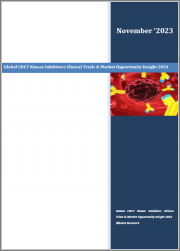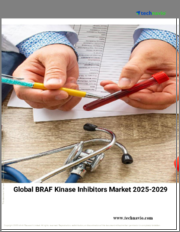
|
시장보고서
상품코드
1378355
세계의 CDC7 키나아제 억제제 : 임상 시험 및 시장 기회(2024년)Global CDC7 Kinase Inhibitors Clinical Trials & Market Opportunity Insight 2024 |
||||||
CDC7 키나아제가 가장 유망한 이유 중 하나는 암 치료제의 표적으로서의 가능성입니다. 암세포의 통제 불가능한 증식에는 DNA 복제의 조절 이상이 관여하는 경우가 많고, CDC7 키나아제는 다양한 암 유형으로 과발현하고 있는 경우가 많습니다. CDC7 키나아제가 저해되면 복제 과정이 저해되어 DNA 손상을 초래하여 세포 사멸로 이어집니다. 그 결과, CDC7 키나아제를 표적으로 함으로써 암의 진행을 멈출 수 있을 것으로 기대되고 있습니다. CDC7 키나아제 억제제는 DNA 복제 과정을 억제하는 데 초점을 맞추므로 보다 특이적이고 독성이 낮은 접근법을 제공할 수 있습니다.
암뿐만 아니라 CDC7 키나아제는 염증성 질환과 바이러스성 질환의 치료에도 주목받고 있습니다. 염증성 질환은 종종 과도한 세포 증식을 수반하지만, CDC7 키나아제를 조절함으로써 이 증식을 억제하고 염증 반응을 완화시킬 수 있습니다. 또한 일부 바이러스, 특히 DNA 바이러스는 자신의 복제에 숙주 세포의 DNA 복제 장치를 사용합니다. 또한,, 최근 수행된 연구는 아비비르나 바이러스와 같은 특정 바이러스가 CDC7을 사용하여 VP3를 인산화시키고 바이러스 복제 능력을 증가시키는 것으로 나타났습니다. CDC7 키나아제를 억제하면 바이러스 복제를 막을 수 있으며 항바이러스 요법에 새로운 접근법을 제공합니다.
또한, CDC7 키나아제 억제제를 기존의 암 화학요법과 병용함으로써 효능이 향상될 가능성이 연구에 나타났습니다. 이러한 치료법의 조합은 암세포의 불균일성을 다루고 암 치료에 종합적인 해결책을 제공할 수 있습니다. 특정 암 유형에서 CDC7 키나아제의 과발현은 치료의 개별화 접근을 가능하게 합니다. 즉, CDC7 키나아제가 과발현된 환자는 맞춤형 치료로부터 큰 이점을 얻을 수 있습니다.
제약회사는 CDC7 키나아제의 잠재력을 인식하고, 이 표적에 대한 억제제를 적극적으로 개발하고 있으며, 임상시험도 일부 실시되고 있습니다. 임상시험이 진행됨에 따라, 항암제 표적, 항염증 표적, 항바이러스 도구로서 CDC7 키나아제의 미래는 점점 유망해지고 있습니다. 이 분야의 지속적인 R&D는 암 치료, 염증성 질환 치료, 항바이러스 전략에 혁명을 가져올 가능성을 가지고 있습니다.
CDC7 키나아제 억제제 임상시험(CDC7 Kinase Inhibitors Clinical Trials) 동향 및 시장 기회를 조사했으며, 기업·적응증·단계별 임상 파이프라인/국가별 동향/개발 촉진 요인 및 과제/경쟁 구도 등을 정리했습니다.
목차
제1장 CDC7 키나아제 억제제 : 소개
제2장 세계의 CDC7 키나아제 억제제 시장 및 임상 동향 : 적응증별
- 백혈병
- 결장직장암
- 췌장암
제3장 세계의 CDC7 억제제 시장 전망
- 현재 시장 전망
- 장래 시장 기회
제4장 CDC7 키나아제 억제제 시장 동향 : 지역별
- 중국
- 일본
- 영국
- 미국
제5장 세계의 CDC7 단백질 키나아제 억제제-임상시험 개요
- 국가별
- 적응증
- 단계
- 치료 클래스
제6장 세계의 CDC7 단백질 키나아제 억제제-임상 파이프라인 : 단계별
- 페이즈 I
- 페이즈 I/II
제7장 세계의 CDC7 키나아제 억제제 시장 : 시장 역학
- 시장 성장 촉진 요인
- 시장 과제
제8장 경쟁 구도
- Carna Biosciences
- Chia Tai Tianqing Pharmaceutical Group
- Eli Lilly
- Memorial Sloan-Kettering Cancer Center
- Schrodinger
“Global CDC7 Kinase Inhibitors Clinical Trials & Market Opportunity Insight 2024” Report Highlights:
- Global CDC7 Kinase Inhibitors Clinical Pipeline By Company, Indication & Phase
- Highest Clinical Phase: Phase-I/II
- US Dominating Global CDC7 Kinase Inhibitors Clinical Trials
- Global CDC7 Inhibitors Market Current & Future Outlook
- CDC7 Kinase Inhibitors Development Trends by Country
- Competitive Landscape
Kinase proteins are targets of upmost importance in the realm of cancer therapeutics because of their ubiquitous roles in numerous cell processes. Research on kinases has spanned several decades, and in the process, a large number of kinases have been identified. One of these, discovered in the early 1970s, is the cell division cycle 7-related protein kinase, or the CDC7 kinase protein that is encoded by the CDC7 gene. Similar to other kinase proteins, CDC7 is needed for several cell processes, including replication, which has brought it into the limelight as another targetable protein for the development of cancer chemotherapies. Despite years of studies, researchers are still trying to understand the function and therapeutic potential of CDC7; however, a couple pharmaceutical companies are already making strides in the pharmaceutical market with their CDC7-inhibiting candidates in development and clinical evaluation.
CDC7 is a serine-threonine kinase. Its significance in the replication process was initially demonstrated using mouse embryonic stem cells, where DNA synthesis was inhibited in the absence of CDC7, resulting in the halting of the S phase at the G2-M DNA damage checkpoint to prevent mitosis with the damaged or incomplete DNA. CDC7 is therefore essential for the initiation of DNA replication process, making it a potential target for various therapeutic applications. CDC7 kinase functions in collaboration with tits regulatory subunit DBF4, forming the CDC7-DBF4 complex. This complex helps regulate the formation of the DNA replication origins, ensuring proper DNA replication and cell division.
One of the most promising aspects of CDC7 kinase is its potential as a cancer drug target. The uncontrolled proliferation of cancer cells often involves dysregulation of DNA replication, and CDC7 kinase is often overexpressed in various cancer types. Inhibition of CDC7 kinase can disrupt the replication process, leading to DNA damage and ultimately, cell death. As a result, targeting CDC7 kinase holds great promise in halting the progression of cancer. Traditional cancer therapies, such as chemotherapy and radiation, target rapidly dividing cells. In contrast, CDC7 kinase inhibitors focus on disrupting DNA replication process, offering a more specific and potentially less toxic approach.
Beyond cancer, CDC7 kinase is also gaining attention for its role in treating inflammatory and viral diseases. Inflammatory diseases often involve excessive cell proliferation, and the modulation of CDC7 kinase can potentially reduce this proliferation, mitigating the inflammatory response. Additionally, some viruses, particularly DNA viruses, reply on host cell DNA replication machinery for their own replication. Moreover, in a recently conducted study, it was shown that certain viruses, like Avibirnavirus, use the CDC7 to phosphorylate the VP3, enhancing the replication ability of the virus. By inhibiting CDC7 kinase, it may be possible to thwart viral replication, offering a new approach in antiviral therapies.
Inhibition of CDC7 offers potential benefits over other cancer therapies. The CDC7 kinase is involved in the DNA replication initiation, and inhibiting it is expected to have minimal off-target interactions, compared to other broadly targeted therapies. In addition, combining CDC7 kinase inhibitors with existing cancer chemotherapies has shown potential for enhanced efficacy in research studies. The combination of these therapies may provide a comprehensive solution to cancer treatment, addressing the heterogeneity of cancer cells. The overexpression of CDC7 kinase in specific cancer types allows for a personalized approach to treatment. So, patients with CDC7 kinase overexpression could benefit significantly from tailored therapies.
Pharmaceutical companies have recognized the potential of CDC7 kinase and are actively developing inhibitors for this target, with a few clinical trials. As clinical trials progress, the future of CDC7 kinase as a cancer drug target, anti-inflammatory target, and antiviral tool is becoming increasingly promising. The continued research and development in this field hold the potential to revolutionize cancer therapy, inflammatory disease treatment and antiviral strategies.
CDC7 kinase is developing as an intriguing player in the pharmaceutical sector, with substantial potential in the treatment of cancer, inflammatory processes, and viral diseases. Its specificity, synergy with existing therapies, and personalized treatment options make it a compelling choice for researchers and clinicians alike. As pharmaceutical companies invest in the development of CDC7 kinase inhibitors, the coming years look bright for this remarkable protein kinase, paving the way for innovative and effective therapeutic options.
Table of Contents
1. Brief Introduction To CDC7 Kinase Inhibitors
- 1.1. Overview
- 1.2. History & Emergence of CDC7 Kinase Inhibitors
2. Global CDC7 Kinase Inhibitors Market & Clinical Trends by Indications
- 2.1. Leukemia
- 2.2. Colorectal Cancer
- 2.3. Pancreatic Cancer
3. Global CDC7 Inhibitors Market Outlook
- 3.1. Current Market Outlook
- 3.2. Future Market Opportunity
4. CDC7 Kinase Inhibitors Market Trend By Region
- 4.1. China
- 4.2. Japan
- 4.3. UK
- 4.4. US
5. Global CDC7 Protein Kinase Inhibitors Clinical Trials Overview
- 5.1. By Country
- 5.2. Indication
- 5.3. Phase
- 5.4. Therapy Class
6. Global CDC7 Protein Kinase Inhibitors Clinical Pipeline By Company, Indication & Phase
- 6.1. Phase-I
- 6.2. Phase-I/II
7. Global CDC7 Kinase Inhibitor Market Dynamics
- 7.1. Market Drivers
- 7.2. Market Challenges
8. Competitive Landscape
- 8.1. Carna Biosciences
- 8.2. Chia Tai Tianqing Pharmaceutical Group
- 8.3. Eli Lilly
- 8.4. Memorial Sloan-Kettering Cancer Center
- 8.5. Schrodinger



















